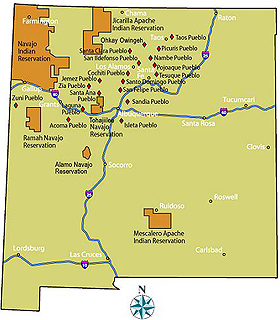Office of the Tribal Liaison
The mission statement of the Office of Tribal Liaison is to promote better health and wellness outcomes among sovereign nations in New Mexico through on-going communication, consultation, and collaboration.
Goals
- Strengthen tribal health and public health systems through on-going collaboration with American Indian tribes, pueblos, and nations that is rooted in tribal leadership guidance in creation, cultivation, and expansion of services and resources which respect the tenets of sovereignty and self-determination held by indigenous nations in the state.
- Assure that the requirements as outlined in the State Tribal Collaboration Act “SCTA” are recognized and adhered to on an on-going basis.
Objectives

Our objective is to strengthen tribal health and public health systems through on-going collaboration with American Indian tribes, pueblos, and nations that is rooted in tribal leadership guidance in creation, cultivation, and expansion of services and resources which respect the tenets of sovereignty and self-determination held by indigenous nations in the state.
- Provide leadership in coordinating more effective leveraging of NMDOH resources dedicated to promotion of equity and reduction of health disparities among American Indian populations through participation in quality improvement, public health accreditation, development of the state health improvement plan, and other strategic initiatives undertaken by NMDOH.
- Serve as a central resource exchange mechanism between tribal and staff NMDOH staff in regards to integration of western science best practices in public health, evidence-based models, and evaluation methods that complement indigenous knowledge and tribal health systems development and improvement.
- Facilitate training to NMDOH staff regarding the State-Tribal Consultation Act (STCA).
- Provide technical assistance to NMDOH staff and programs in the development and implementation of policies, agreements, and programs that directly affect American Indian populations.
History
NMDOH has a long history of working and collaborating with American Indian nations, pueblos, tribes in New Mexico, as well as Off-Reservation Groups.
NMDOH was a key participant in the development of the 2007 Health and Human Services (HHS) Department’s State-Tribal Consultation Protocol (STCP). The purpose of 2007 STCP was to develop an agreed-upon consultation process for the HHS Departments as they developed or changed policies, programs or activities that had tribal implications. The 2007 STCP provided both Departments with critical definitions and a communication policy, procedures, and processes that have guided agency activities over several years.
However, with the signing of Senate Bill 196 (State Tribal Collaboration Act) in 2009, a new commitment was established that required the State to work with the American Indian tribes, pueblos, and nations of New Mexico on a government-to-government basis. An Interagency Group comprised of representatives from NMDOH; Aging and Long Term Services Department; Children, Youth, and Families Department; Department of Veterans’ Services; Human Services Department; Indian Affairs Department; Office of African American Affairs, and several tribes met to develop an overarching policy that:
- Promotes effective collaboration and communication between the agency and Tribes. See the State-Tribal Collaboration Act Agency Report 2014.
- Promotes positive government-to-government relations between the State and Tribes.
- Promotes cultural competence in providing effective services to American Indians/Alaska Natives.
- Establishes a method for notifying agency employees of the provisions of the State Tribal Collaboration Act and the State Tribal Consultation, Collaboration and Communication Policy that the agency adopts.
- Use of the processes and protocol is an established policy at NMDOH.
- State Tribal Collaboration Act Reports (STCA):
- State-Tribal Collaboration Act Agency Report 2024
- State-Tribal Collaboration Act Agency Report 2023
- State-Tribal Collaboration Act Agency Report 2022
- State-Tribal Collaboration Act Agency Report 2021
- State-Tribal Collaboration Act Agency Report 2020
- State-Tribal Collaboration Act Agency Report 2019
- State-Tribal Collaboration Act Agency Report 2018
- State-Tribal Collaboration Act Agency Report 2017
- State-Tribal Collaboration Act Agency Report 2016
- State-Tribal Collaboration Act Agency Report 2015
- State-Tribal Collaboration Act Agency Report 2014
- State-Tribal Collaboration Act Agency Report 2013
- State-Tribal Collaboration Act Agency Report 2012
- State-Tribal Collaboration Act Agency Report 2011
- State-Tribal Collaboration Act Agency Report 2010
- State-Tribal Collaboration Act Agency Report 2009
Toolkit

The New Mexico Department of Health (NMDOH) has developed a new toolkit that provides practical resources and guidance to tribal farmers and ranchers to address a gap in getting raw produce and livestock from field and range to market.
In this toolkit, you will find multiple areas to help turn farming and ranching into a successful business, or establish yourself as an entrepreneur. These subject areas include Business Start-Up Resources, Money Management and Business Funding, and Selling.
Please see the Tribal Farming Toolkit to learn more.
Read the Agricultural Plan Tribal Roundtable Report 2018 to learn more about the outcomes of the roundtable meeting held June 20, 2018.
Educational References
For those who are interested in learning more about Native American tribes, here are some helpful articles:
- Look to the Mountain: An Ecology of Indigenous Education (1993). Greg Cajete, PhD. This book explores the nature of indigenous education, outlining key elements of American Indian perspectives on learning and teaching.
- Native American Post Colonial Psychology (1995). Eduardo Duran and Bonnie Duran.
- The Pueblo Revolt: The Secret Rebellion that Drove Spaniards out of the Southwest. The dramatic and tragic story of the only successful Native American uprising against the Spanish, the Pueblo Revolt of 1680.With the conquest of New Mexico in 1598, Spanish governors, soldiers, and missionaries began their brutal subjugation of the Pueblo Indians in what is today the Southwestern United States.
- Dine Bahana: The Navajo Creation. This is the most complete version of the Navajo creation story to appear in English since Washington Matthews' Navajo Legends of 1847. Zolbrod's new translation renders the power and delicacy of the oral storytelling performance on the page through a poetic idiom appropriate to the Navajo oral tradition. Zolbrod's book offers the general reader a vivid introduction to Navajo culture.
- Pueblo Nations: Eight Centuries of Pueblo Indian History. Pueblo Nations is the story of a vital and creative culture, of a people sustained by ages-old traditions and beliefs, who have adapted to the radical challenges of the modern world.
- Pueblo Profiles: Cultural Identity Through Centuries of Change. Joe S. Sando weaves a tapestry of individual lives against a backdrop of history -- telling the stories of political leaders, educators, and artists who took part in the events and movements that have shaped Pueblo Indian life from the time of the Pueblo Revolt to the present day.
- Indian Country 101: An introduction to Tribal Nations and the United States (February, 2019).
Tribal Liaison

The Tribal Liaison for NMDOH is Janet Johnson and she can be reached by phone at (505) 827-2627.
The OTL Project Coordinator position is vacant.
Each agency has a Tribal Liaison and their contact information can be found on the New Mexico Indian Affairs Department (IAD) website.
In acknowledging state-tribal relationships, New Mexico is unique and leads the nation in having the only Cabinet-level Secretary for Indian Affairs.

